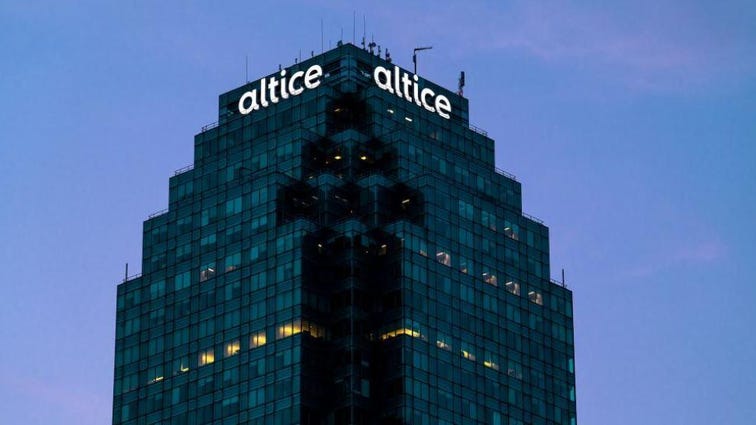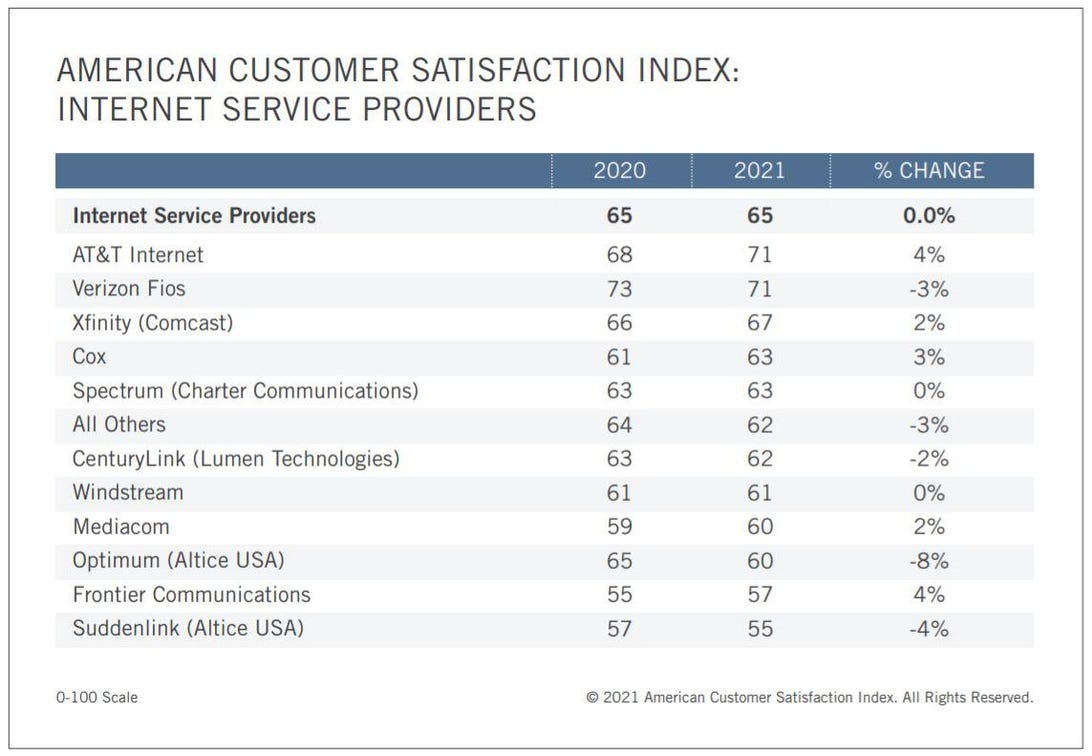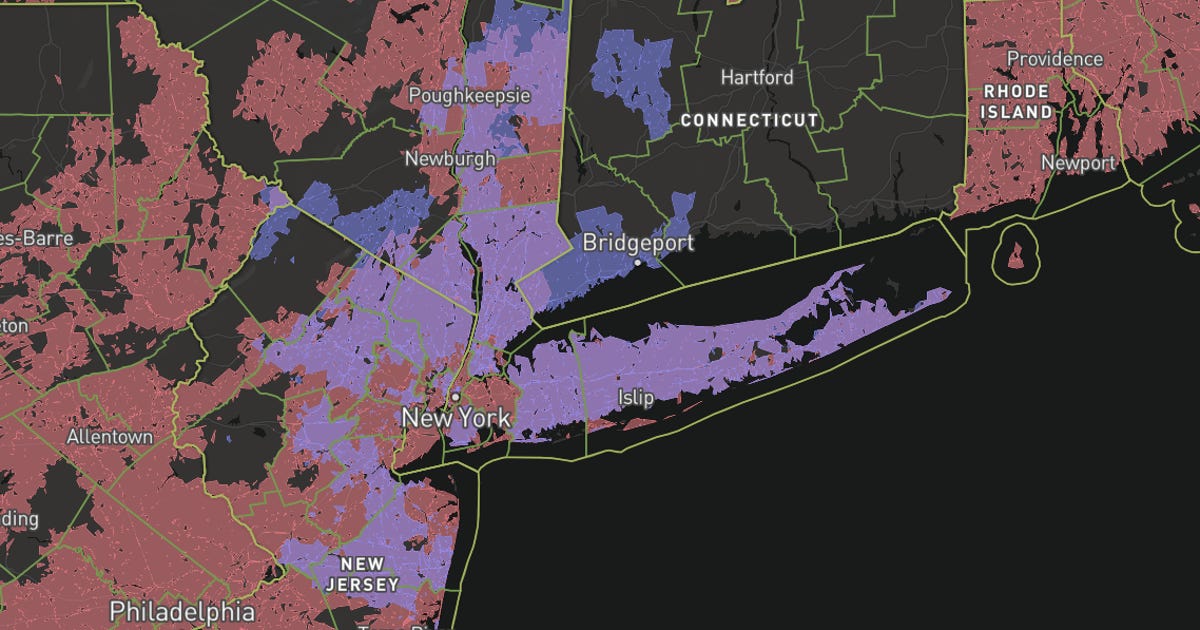Table of Contents
If you live in the northeastern US, you may likely be considering either Optimum or Verizon Fios for your home internet. These two providers offer broadband service to some major metro areas in that portion of the country and if you live in parts of Connecticut, New Jersey and New York, you might even have a choice between the two.
According to the latest data from the Federal Communications Commission, Optimum is available to just shy of 13 million people and Verizon Fios is offered to nearly 36 million potential customers. So there may be quite a few of you out there looking into these two internet service providers and wondering what the differences are between them. Let’s take a look.

Optimum
Out of the gate, there’s a lot to lure you to Altice’s Optimum internet service. You get extremely competitive introductory pricing, fast speeds and decent perks. Along with those positives, you get unlimited data, no contracts and low equipment fees. What’s not to like?
Well, there are a few other factors to consider. A majority of households serviceable for Optimum will receive cable internet service, which can get you fast download speeds, but not the equal upload speeds you would find with fiber-optic service. Also, while the introductory prices are great, they’re only good for the first year. Lastly, Optimum has not fared all that well in customer satisfaction surveys, so there’s work to be done there, too.
Read our Optimum home internet review.

Smith Collection/Gado/Getty Images
Verizon Fios is a 100% fiber internet service, which means you get symmetrical download and upload speeds. That’s good, especially if you’re spending more time working from home and videoconferencing these days. The high performance and speedy uploads of fiber internet let you accomplish those things better than cable internet, where upload speeds are typically much slower.
Also, Verizon Fios doesn’t flood you with a bunch of qualifications or caveats about its service. It keeps things simple with just three plans, and you don’t have to worry about any early termination or overage fees because there are no data caps and no contracts. Granted, Verizon Fios doesn’t feature the lowest prices, but it offers excellent value in the long run and scores exceptionally well in customer satisfaction rankings.
Read our Verizon Fios home internet review.
Verizon Fios and Optimum have coverage maps that overlap throughout much of New York City and the surrounding areas.
FCC/Mapbox
Where can you get Verizon Fios and Optimum?
Verizon Fios focuses its coverage on several major metro areas in the Northeast. Some of those cities include Albany, New York; Baltimore; Boston; Buffalo, New York; Philadelphia; Pittsburgh; Richmond, Virginia; Syracuse, New York; and Washington, DC. All in all, Verizon Fios spans the eight states of Delaware, Maryland, Massachusetts, New Jersey, New York, Pennsylvania, Rhode Island and Virginia.
Optimum Internet is available to two boroughs in the New York City market — Brooklyn and the Bronx. It is also available to the majority of Long Island as well as a healthy section of northern New Jersey, Dutchess and Westchester counties in New York state and portions of Connecticut.
As I mentioned at the start, there’s some decent crossover between these two ISPs, mainly within the New York metropolitan area.
What’s the difference between Optimum and Verizon Fios plans and prices?
On its site, Verizon Fios boasts that its upload speeds are “up to 25x faster than Optimum’s cable network.” On the flip side, Optimum brags, “If you are being mindful of your budget, Optimum is the better choice.” Let’s start sorting through it all by starting with their available plans and price points.
Optimum plans and pricing
| Plan | Max speeds | Starting monthly price | Regular monthly rate | Monthly equipment fee | Data cap | Contract |
|---|---|---|---|---|---|---|
| Optimum 100 | 100Mbps download, 5Mbps upload | $30 | $90 | $10 (skippable) | None | None |
| Optimum 300 | 300Mbps download, 20Mbps upload | $30 | $110 | $10 (skippable) | None | None |
| Optimum 500 | 500Mbps download, 20Mbps upload | $40 | $130 | $10 (skippable) | None | None |
| Optimum 1 Gig | 940Mbps download, 35Mbps upload | $50 | $140 | $10 (skippable) | None | None |
Verizon Fios plans and pricing
| Plan | Max speeds | Starting monthly price | Regular monthly rate | Monthly equipment fee | Data cap | Contract |
|---|---|---|---|---|---|---|
| Fios 200 | 200Mbps download, 200Mbps upload | $40 | $40 | $15 (skippable) | None | None |
| Fios 400 | 400Mbps download, 400Mbps upload | $65 | $65 | $15 (skippable) | None | None |
| Fios Gigabit Connection | 940Mbps download, 880Mbps upload | $90 | $90 | None | None | None |
Let’s start with Optimum. As is the case with many ISPs, the number of plans available to you will vary based on your location and address. Instead of the 100 and 300 plans, some customers might see either a 200 megabits-per-second plan or a 400Mbps option. But what stands out is the highly competitive pricing for the first 12 months of service. Taken across all four plans, the cost per Mbps of Optimum’s starting monthly prices is a very affordable 13 cents per Mbps. Even more impressive? The cost per Mbps for the Optimum 1 Gig plan is 5 cents. That’s why my CNET colleague David Anders tagged Optimum as the best cable gigabit internet deal in his roundup of the best high-speed ISPs for gigabit internet.
The drawbacks? First, you can see how cable’s upload speeds don’t compare to those of fiber internet. You only get 5Mbps of upload speed with Optimum 100 and between 20 and 35Mbps for the other three plans. What does that mean in the real world? Well, Zoom recommends you have at least 2Mbps upload speeds for a single screen, so if you’ve got a household with two or three people needing to do some form of videoconferencing, things could get real tight quick. Fiber won’t run into that problem.
Second, those fantastic introductory prices don’t last. After your first year of service, the plan costs revert to Optimum’s regular rates, which, on average across all four plans, jumps up to 42 cents per Mbps. Not the worst we’ve seen, but after those initial 12 months, it certainly becomes more expensive than Verizon Fios.
That said, CNET spoke with an Altice spokesperson about the second-year rates and we were assured that customers will not see quite those same jumps. “Customer pricing may change after the initial promotional period ends, but will not go to full rate card pricing. We communicate the exact change in pricing to our customers in advance of the adjustment taking effect.”
Moving on to Verizon Fios, it tries to keep things pretty similar across all the areas it serves. The three plans you see are the three plans offered. And those three plans don’t have a promo price that changes to a regular rate after 12 months. That doesn’t mean your rate will never change, of course, but it also means you’re not fated to get that dreaded bump in your bill after a year. So, when looking across Verizon Fios’ three plans, the cost per Mbps for Fios 200 at 20 cents is cheaper than the 30 cents per Mbps of Optimum 100’s starting price and the overall price of 15 cents per Mbps across all plans is comparable to Optimum.
The one exception — though in this case, it’s an important one — is in New York City. Verizon Fios features both a Fios 300 and Fios 500 plan to match the speeds that Optimum offers. The New York City Fios 300 plan exactly matches the $40 a month intro rate that Optimum charges, while the Fios 500 plan runs $65 a month (vs. Optimum’s $50 a month for the first 12 months).
So, who wins this round?
It depends. Optimum features better prices for the first 12 months, but Verizon Fios may end up being cheaper in the long run. In addition, the symmetrical upload speeds you get from a fiber connection also bring a particular worth of their own. On that note, Optimum also sees the value of fiber internet. Per Altice’s Q2 report from late July, Optimum’s 100% fiber network is currently available to just over 20% of its Optimum footprint and a spokesperson shared with CNET Optimum’s goal that “fiber deployment continues at a rapid pace.” It’s not yet widely available, but Optimum is certainly pushing further down that road.
Let’s take a look at additional fees and add-on expenses
Both Verizon Fios and Optimum waive your setup if you order service online, so we’ve got a draw there. Both ISPs have also kicked data caps to the curb, so you don’t need to fear any looming overage fees for your data usage. That’s a win for customers of both services. Lastly, neither Verizon Fios or Optimum require you to sign a contract, so there’s no threat of steep early-termination fees.
Where we do have some variance between the two is with your monthly equipment fee. Verizon Fios will charge you an additional $15 a month to rent their router. That fee does get waived if you sign up for the Fios Gigabit service. You could also make a one-time purchase of the router for $300, which essentially means you’re paying for 20 months up front and then getting the service for free. That’s worth considering if you have some certainty you won’t be moving in the next two years.
Optimum wins this battle as its monthly equipment fee rings in at $10 a month. That’s a third less expensive than Verizon Fios. It should also be noted that both Optimum and Verizon Fios also give you the option to skip additional monthly equipment fees altogether by using your own modem and router.
Are there perks to help earn your business?
Perhaps because they both compete in the country’s largest metro market, both Optimum and Verizon aren’t shy about courting customers.
On the Optimum front, all new internet customers will receive a $100 Visa Prepaid Card — and special mobile pricing — if they add Optimum Mobile to their service. In addition, new subscribers to the 300, 500 or 1 Gig plan will also receive a $200 Visa Prepaid Card, a free Wi-Fi extender and free internet for a month (which will appear as a credit on your third bill). Lastly, Optimum 300 customers will get three months of HBO Max for free, Optimum 500 customers get six months free and Optimum 1 Gig customers get a full year of HBO Max for free. At $15 a month, that’s a nice little perk.
Optimum also offers a 60-day money-back guarantee, which is twice as long as the 30 days offered by most other ISPs. It features a contract buyout as well. If you go to Optimum with a bill from a competing provider — let’s say you recently moved to an Optimum-serviceable address and you’re coming from another region where you had a contract with your ISP — it will give you a credit to cover the early termination fee you incurred, up to a maximum amount of $500.
Verizon Fios has some similar deals and offers to sway you its way. First, like Optimum, it extends an Early Termination Fee offer. Specifically, you’ll get a bill credit of up to $500 if you switch from your current provider and are charged a termination fee for breaking the contract. Second, Verizon also boasts a money-back guarantee offer, but unlike Optimum’s 60-day window, the money-back offer is viable for your first 30 days of service.
As for perks, all new Verizon Fios customers will receive AMC Plus for 12 months. That’s a value of $9 a month. If you sign up for the 400Mbps plan, you’ll also get a $100 Verizon Gift Card. Lastly, new Gigabit customers will get a $200 Verizon Gift Card, a Wi-Fi extender (in addition to the free router I mentioned earlier) and 2TB of Verizon Cloud storage.
Personally, I’d rather have HBO Max than AMC Plus. But aside from whether you’d rather watch Curb Your Enthusiasm (HBO Max) or The Walking Dead (AMC Plus) — the better value is with the $15-a-month HBO Max over the $9-a-month AMC Plus. You shouldn’t let it be the sole reason you choose one service over the other, but it could undoubtedly sway your decision if you’re on the fence.

American Customer Satisfaction Index
Where does customer satisfaction land?
There’s no other way to put this — Optimum has a long way to go to match the customer satisfaction track record of Verizon Fios. Let’s start with the 2021 American Customer Satisfaction Index for ISPs. Verizon Fios tied with AT&T at the top of the chart with 71 out of 100. It was the sixth straight year that Verizon landed at the top of this benchmark survey. The only blemish is that Verizon Fios dipped by two points from the previous year.
Unfortunately for Optimum, the ACSI survey had much harsher news. Optimum scored a 60 out of 100, which was five points below the industry average. Even more distressing, it was five points lower than the previous year’s rating, which signaled a near 8% drop, the steepest decline of any ISP named in the study.
Over at the 2021 J.D. Power US Residential Internet Service Provider Satisfaction Study, the news wasn’t much better for Optimum. The company earned a disappointing score of 655 on a 1,000-point scale, which was well below the East region average of 714 and a drop from last year, where it had almost overtaken Spectrum. Instead, it bested only Frontier Communications at the bottom of the list.
Meanwhile, Verizon Fios also took the top spot in this satisfaction survey, earning a 758 out of 1,000. To be fair, this was also a drop from its 2020 score, but well above the second-place Xfinity in the same East region. In fact, of all ISPs in the J.D. Power survey, Verizon Fios boasted the highest score across all regions.
Verizon Fios took the top spot in the East region of J.D. Power’s most recent ISP customer satisfaction survey. Optimum? It was near the bottom, second only to Frontier Communications.
J.D. Power
What’s the final verdict?
If you have a choice between Verizon Fios and Optimum, it’s tough not to go with Verizon Fios. First off, from reliability to the symmetrical download and upload speeds, a 100% fiber network will beat cable internet every time. And, despite the compelling savings you’ll get in the first year of service with Optimum, Verizon’s consistently strong customer satisfaction ratings are enough to put it over the top.
https://www.cnet.com/home/internet/optimum-vs-verizon-fios/






More Stories
Putting Online Infrastructure Electricity on Your Radar
AI Accelerates Online Flexibility Decline, Report Finds
Net dependancy spectrum detailed in review: Where by do you level?